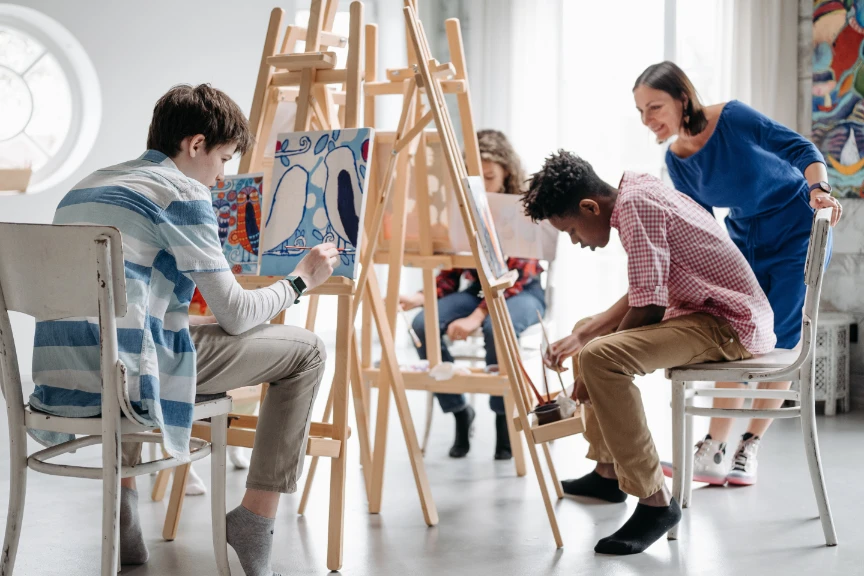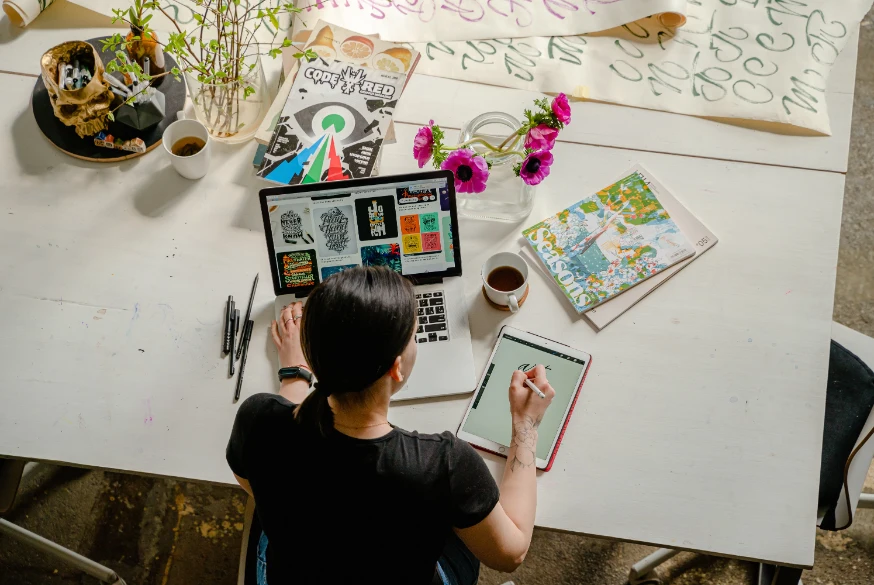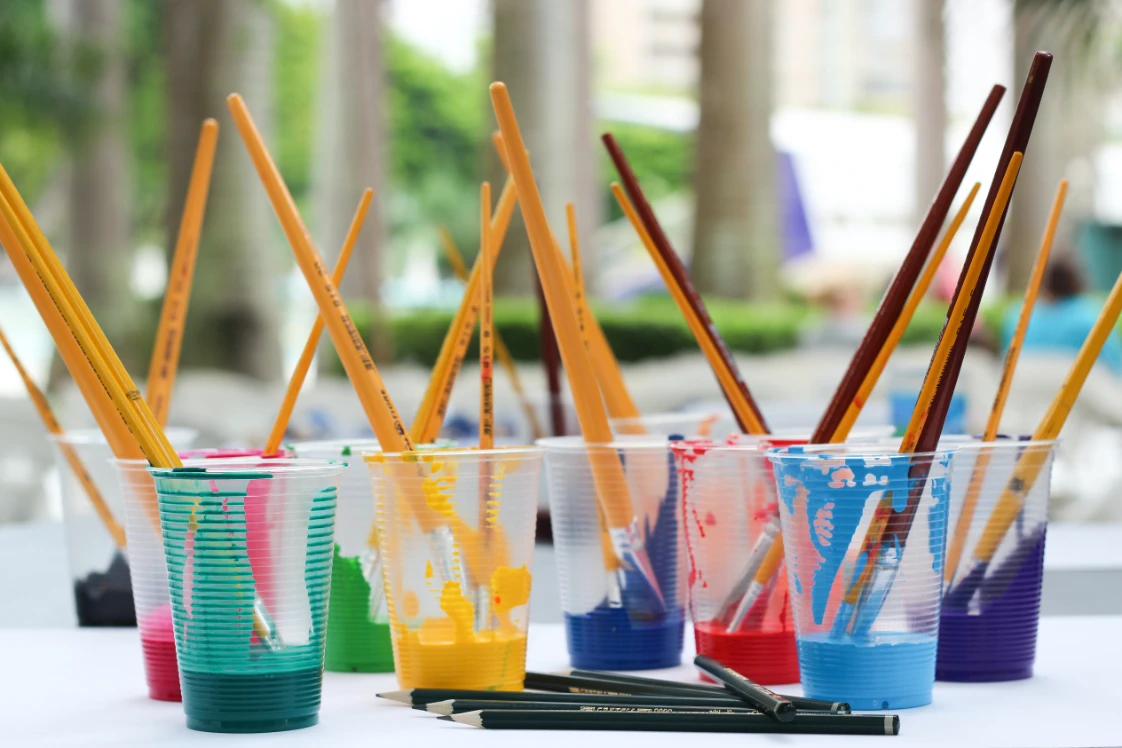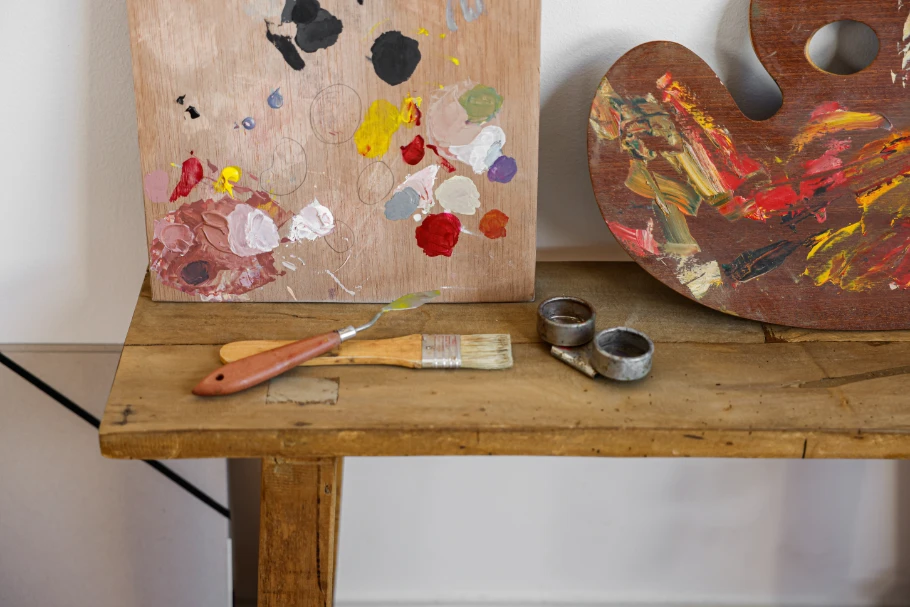Imagine standing in front of a blank canvas, brush in hand, with nothing but a vague idea of what you want to create. Without clear and defined artistic goals, this scenario can be overwhelming and lead to a lack of direction and inspiration.
However, setting specific and achievable goals for your art can open up a world of possibilities and help bring your creative visions to life.
Meaning of Artistic Goals
Artistic goals refer to the specific objectives or aspirations that an artist sets for themselves in their creative pursuits.
These goals can be both short-term and long-term, and can encompass a wide range of areas such as developing technical skills, exploring new mediums, creating a specific piece of work, or even building a career in the art world.
“Art is not just about creating something beautiful, it’s about channelling your innermost thoughts and emotions into a masterpiece.”
MAK
Setting artistic goals allows an artist to have a clear direction and focus in their work, and to track their progress over time. Examples of artistic goals can be learning a new painting technique, creating a series of artworks, participating in an art show, or building a personal brand as an artist.
Examples of Artistic Goals
Here are some examples of artistic goals:
- To complete a series of paintings exploring the theme of nature within a year.
- To learn a new medium such as sculpture or printmaking within 6 months.
- To create a portfolio of works to apply for a residency program in 2 years.
- To increase the number of followers on their social media platforms in order to get more visibility and exposure.
- To write a book/script/play, finish it and get it published/produced within 3 years.
- To improve drawing skills by taking a course and practice regularly for a year.
- To participate in a group, show or exhibition in a gallery within a year.
- To create a website and start selling art online within 6 months.
- To learn a new software to create digital art and finish a project within a year.
- To create a project that addresses a social issue and share it with a community through a public exhibition or a social media campaign.

Importance of Setting Artistic Goals for Beginners
Setting artistic goals is important for several reasons:
- Provides direction and focus: Having specific and well-defined goals helps an artist to focus their efforts and energy on what they want to achieve. This allows them to prioritize their time and resources and to work towards a clear outcome.
- Helps measure progress: Setting goals allows an artist to measure their progress over time. This can be a powerful motivator, as it allows the artist to see how far they have come and to celebrate their achievements.
- Encourages experimentation and growth: Setting goals can also push an artist out of their comfort zone, encouraging them to try new techniques, mediums or subjects that they might not have otherwise explored.
- Helps build a successful art career: For artists who want to build a career in the art world, setting goals is essential. It can help them identify their strengths, weaknesses, and areas for improvement, and create a plan to achieve their aspirations.
In summary, setting artistic goals allows an artist to have a clear direction, to measure progress, and to encourage experimentation and growth, which is crucial for the development of an artist and for the success of an art career.
How to Set Artistic and Smart Goals?
Setting artistic goals is an important step in achieving success as an artist. The process starts with brainstorming ideas, considering what you want to accomplish, and what areas you want to focus on.
Once you have a list of ideas, prioritize them according to what is most important to you.
Then, create a plan of action by breaking down your goals into smaller, more manageable tasks. This will make it easier for you to track your progress and stay on track.
It’s also important to be realistic when setting goals, considering your current skill level and the resources available to you.
Remember to make your goals specific, measurable, achievable, relevant, and time-bound (SMART Goals) to increase the chances of achieving them.
SMART is an acronym that stands for Specific, Measurable, Achievable, Relevant, and Time-bound. It’s a framework that can help you set clear and effective goals.
- Specific: A specific goal is one that is clear and well-defined, with a clear outcome in mind. It answers the questions of what, why, and how.
- Measurable: A measurable goal is one that can be quantified or tracked in some way, so that you can measure your progress and see how close you are to achieving it.
- Achievable: An achievable goal is one that is realistic and within your reach, given your current skills and resources.
- Relevant: A relevant goal is one that is aligned with your overall aspirations and that is meaningful to you.
- Time-bound: A time-bound goal is one that has a deadline or time frame associated with it, so that you have a clear sense of when you need to achieve it by.
Using SMART goals can help you set clear and effective goals, increase your chances of achieving them, and make it easier to measure your progress.
1. Brainstorming Ideas
Brainstorming is a creative process that involves generating a large number of ideas in a short amount of time.
The goal of brainstorming is to generate as many ideas as possible, without worrying about their feasibility or whether they are good or bad.
The focus is on generating a wide variety of ideas, rather than judging or evaluating them.
When brainstorming ideas for artistic goals, you can start by asking yourself questions such as: What do I want to accomplish? What areas do I want to focus on? What new techniques or mediums do I want to explore? What specific pieces of work do I want to create?
There are different ways to brainstorm, you can do it individually or in a group. Some people prefer to write down their ideas while others prefer to draw or sketch them out.
You can also use different techniques like mind mapping, free writing, or random word association.
It’s important to keep an open mind when brainstorming and not to limit yourself. The idea is to come up with as many ideas as possible, so don’t be afraid to think outside the box.
Brainstorming is a great way to generate a wide variety of ideas, which can then be narrowed down and refined to create specific and achievable goals.

2. Prioritizing Goals
Prioritizing goals is the process of organizing and ranking your goals in order of importance. It involves evaluating your goals and determining which ones are most critical to achieving your overall objectives.
When prioritizing your artistic goals, you should consider factors such as the level of difficulty, the resources required, the time frame, and the potential impact of each goal.
For example, a goal that requires a significant investment of time and resources may be less important than a goal that can be achieved quickly and with minimal resources.
Once you have a list of goals, it’s important to rank them in order of importance. Some goals may be more critical than others, and it’s essential to focus on the most important ones first.
This will help you to maximize your time and resources, and increase your chances of achieving your goals.
It is also important to review your goals regularly, and adjust them as necessary. This will allow you to adapt to changes in your life, and ensure that your goals remain relevant and achievable.
3. Creating a Plan of Action
Creating a plan of action is the process of breaking down your goals into smaller, more manageable tasks. It’s an essential step in achieving your goals, as it helps you to stay focused and organized, and makes it easier to track your progress.
When creating a plan of action for your artistic goals, you should start by identifying the specific steps that you need to take to achieve each goal.
For example, if your goal is to create a specific piece of artwork, your plan of action might include tasks such as researching materials, sketching out ideas, and creating a rough draft.
It’s also important to set deadlines for each task and to schedule them into your calendar. This will help you to stay on track and to ensure that you are making progress towards your goals.
Additionally, it’s essential to be flexible, and adjust your plan as necessary. Sometimes, unexpected obstacles or opportunities may arise, so it’s essential to be able to adapt your plan and to adjust as needed.
In summary, creating a plan of action is an essential step in achieving your artistic goals. It helps you to stay focused, organized, and on track, and makes it easier to measure your progress.
Achieving Artistic Goals
Achieving artistic goals requires a combination of determination, hard work, and a strategic approach.
It starts with setting clear, specific and achievable goals, and then creating a plan of action that breaks down these goals into smaller, more manageable tasks. Prioritizing your goals, tracking your progress and staying focused on your goals is also important.
Additionally, having a growth mindset, being open to feedback and learning from your mistakes can help you achieve your artistic goals.
It’s also important to have a balance of self-discipline and self-care, taking care of yourself physically and mentally can help you stay motivated and energized to work towards your goals.
Achieving artistic goals also requires patience and perseverance, as it may take time to master new skills or to see progress in your work.
However, by staying focused on your goals, and being willing to put in the effort, you can achieve your artistic goals and continue to grow as an artist.
1. Overcoming Obstacles
Overcoming obstacles refers to the process of dealing with and overcoming challenges that may arise while working towards achieving your goals.
These obstacles can come in many forms, such as lack of motivation, lack of resources, lack of support, or simply a lack of progress.
When it comes to artistic goals, obstacles may include difficulty finding inspiration, difficulty with a specific medium or technique, or difficulty getting feedback or recognition.
To overcome these obstacles, it’s essential to have a plan in place for dealing with them.
This might include setting smaller, more manageable goals, seeking out inspiration and feedback, or experimenting with different techniques or mediums.
It’s also important to stay positive and to maintain a growth mindset. This means viewing obstacles as opportunities to learn and grow, rather than as failures or setbacks.
It can be helpful to have a support system, whether it’s a friend, family member, or mentor, who can provide encouragement and guidance when you’re facing obstacles.
Additionally, it’s important to take care of yourself physically and mentally, and to take breaks when needed.
Overcoming obstacles is an important part of achieving your artistic goals. It requires being prepared, staying positive, and having a plan in place for dealing with challenges. It’s also essential to take care of yourself and to have a support system in place.

2. Staying Motivated
Staying motivated refers to the ability to maintain enthusiasm and interest in working towards a goal over time. It’s an important aspect of achieving any goal, including artistic goals.
There are many ways to stay motivated, such as setting clear, specific and achievable goals, breaking those goals into smaller, manageable tasks and creating a plan of action.
Prioritizing goals, tracking progress, and celebrating small wins along the way can also help to maintain motivation.
Another way to stay motivated is to surround yourself with inspiration, whether it’s through other artists, artwork, or quotes, it can help to keep your focus on your goals.
It can also be helpful to set yourself rewards for meeting certain milestones in your artistic journey, such as treating yourself to a new art supply or taking a day off to celebrate your progress.
Having a support system, such as friends, family or a mentor can also provide encouragement and help to keep you motivated.
It’s also important to practice self-care and to take care of yourself physically and mentally. This can help to reduce stress, boost your mood and energy, and keep you motivated to work towards your artistic goals.
Staying motivated is essential to achieving your artistic goals. It requires setting clear, specific and achievable goals, breaking them into smaller manageable tasks, creating a plan of action, tracking progress, and celebrating small wins.
It also requires surrounding yourself with inspiration, setting rewards, having a support system, and taking care of yourself physically and mentally.
3. Seeking Feedback and Critiques
Seeking feedback and critiques refers to the process of soliciting opinions and suggestions from others in regards to one’s artwork or artistic process. It can be an important aspect of the artistic journey, as it allows the artist to gain a different perspective on their work and to identify areas that need improvement.
Giving and receiving feedback can be done in many ways, such as through formal critiques by art professionals, informal critiques by peers, or through online communities and platforms.
When seeking feedback, it’s important to be open-minded and to try not to take criticism personally. Instead, try to view feedback as an opportunity to learn and grow as an artist.
It’s also important to be specific with the type of feedback you’re seeking. For example, if you’re having trouble with a specific technique or medium, you may ask someone who has experience with that particular technique or medium to give you feedback.
When receiving feedback, it’s important to consider the source. Feedback from someone who is well-versed in the subject matter or who has a similar artistic style can be particularly valuable.
Additionally, it’s important to remember that feedback is just one person’s opinion, and not everyone will agree with it, so it’s important to consider all the feedback you receive, but ultimately make your own judgement based on what feels right to you and your artistic vision.
Measuring Success
Measuring success in the realm of art can be a tricky task, as success is often subjective and dependent on the individual artist’s goals and aspirations.
However, it is important to have some way to measure progress and success in order to track the development of the artist’s work and to identify areas that need improvement.
1. Defining Success for Yourself / Your Goals as An Artist
Defining success for yourself refers to the process of determining what personal goals and aspirations you want to achieve as an artist, and how you will measure progress and success towards those goals.
It is an important step in the process of setting and achieving artistic goals, as it allows you to have a clear understanding of what you want to accomplish, and to stay focused on your vision.
When defining success for yourself, it is important to consider your own values, interests, and passions.
For example, if you are passionate about exploring new techniques and experimenting with different mediums, then success for you may be defined as mastering a new skill or creating a unique piece of art.
It’s also important to remember that success doesn’t have to be measured in traditional terms such as sales, fame, or critical acclaim.
For some artists, success may be defined by the personal satisfaction they get from creating art, or by the impact their art has on others.
When defining success for yourself, it’s important to be specific, realistic and make it achievable. Setting SMART goals can be a great way to achieve this.
2. Evaluating Progress
Evaluating progress is an essential step in the process of achieving artistic goals. It allows you to track your progress towards your goals and to adjust as needed.
The process of evaluating progress involves regularly reviewing your goals, your plan of action, and your work, and assessing how well you are doing in each of these areas.
One way to evaluate progress is by keeping a journal or a portfolio of your work. This can help you to see how your skills and style have developed over time, and to identify areas that need improvement.
It’s also important to reflect on your goals and see if they are still relevant or if they need to be adjusted.
Another way to evaluate progress is through feedback and critiques. This can include feedback from peers, art professionals, and the general public, as well as awards, recognition, and other forms of validation. This feedback can help you identify your strengths and weaknesses, and to adjust accordingly.
Finally, evaluating progress also involves self-evaluation, where the artist reflects on their artistic growth, the level of skill and craftsmanship achieved, and the satisfaction they get from the process of creating art.

3. Celebrating Milestones
Celebrating milestones is an important aspect of achieving artistic goals. It is a way to acknowledge and appreciate the hard work and dedication that goes into creating art, and to recognize the progress that has been made towards achieving one’s goals.
Celebrating milestones can take many forms, depending on the artist and the goal that has been achieved.
One way to celebrate milestones is by sharing your work with others. This can include exhibiting your work in a gallery, participating in a group show, or displaying your work online.
Sharing your work with others allows you to receive feedback and recognition, and to connect with other artists and art enthusiasts.
Another way to celebrate milestones is by setting a specific reward for achieving a goal. For example, if your goal is to complete a certain number of paintings, you might reward yourself with a trip to an art supply store or a new set of paints.
Finally, celebrating milestones can also be a personal and intimate moment, where the artist reflects on their journey, the challenges overcome and the satisfaction achieved.
Encouraging Readers to Set Their Own Artistic Goals
Encouraging readers to set their own artistic goals and strive to achieve them is a way to motivate and inspire them to act towards achieving their own creative aspirations.
Setting artistic goals can help readers to focus their efforts and to develop their skills and abilities as an artist.
By setting and working towards specific, measurable goals, readers can gain a sense of accomplishment and satisfaction as they make progress towards achieving their goals.
One way to encourage readers to set their own artistic goals is by sharing examples of successful artists who have set and achieved their own goals.
This can include stories of how they set their goals, the strategies they used to achieve them, and the impact that achieving their goals had on their careers and lives.
To sum up this article, encouraging readers to set their own artistic goals and strive to achieve them is a way to motivate and inspire them to act towards achieving their own creative aspirations.
It can be done by sharing examples of successful artists, providing them with the tools and resources they need, and providing guidance and support.



